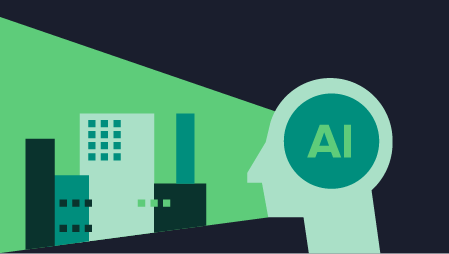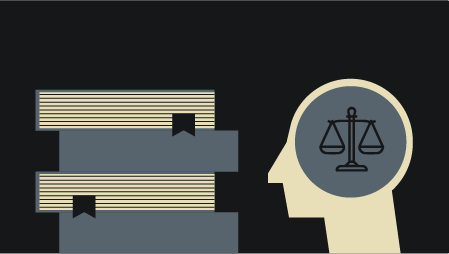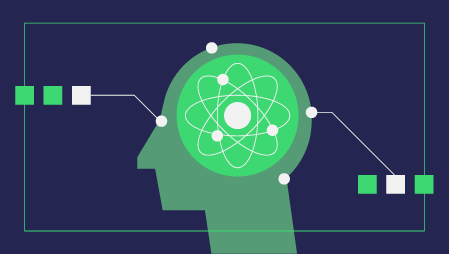Check out part one and two of this series for the first five and fifty years in AI. In part three we push the very limits of reality and look 500 years into the swirling depths of tomorrow.
“Difficult to see. Always in motion is the future.” — Yoda.
2519.
Humanity finally burst free of the bonds of that frail blue planet drifting lonely in space.
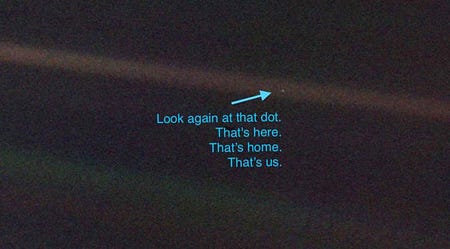
The pale blue dot.
We’ve spread out towards the stars and colonized the solar system, from settlements orbiting the glittering rings of Saturn, to sprawling cities on the red hills of Mars built by nano insects invisible to the eyes.
Massive robotic ships lower their long elephant trunks and slurp helium and precious gases from the depths of Jupiter. When their big bellies are filled to bursting, they rocket along invisible superhighways, delivering He3 to energy hungry fusion micro-reactors that power the interplanetary economy.
Beyond the rings, deep space mining ships release clouds of drones like baby spiders into the wind and they digest asteroids hurtling in the endless void. The drones fuel an unprecedented building boom on nearly every planet circling the sun, as city after city goes up on barren rocks long hostile to organic life.
The fastest transformations are taking place on Mars. The once dead ocean of red dust now seethes with new life.
The people who immigrated to Mars generations ago don’t need oxygen at all. They’re genengineered to breathe the carbon dioxide saturated sky, though their lungs can switch back and forth between oxygen and CO2 as easily as flipping a light switch.
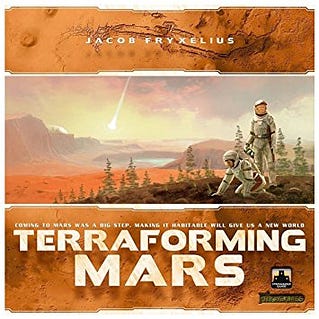
You won’t make it to Mars but you can play the board game!
And the great terraforming of Mars moves faster and faster with each passing standard-year. Gigantic atmospheric processors, created by the biggest interstellar conglomerate DAOs (Decentralized Autonomous Organizations) churn the deadly air, slowly making it breathable for oxygen dependent creatures.
But it’s not just the air that’s changing. Skyscraper sized machines gouge the red soil, ripping it apart to make an ocean, the largest undertaking ever attempted by mankind.
“Natural born” Martians resist the cataclysmic forces of terraforming and the radical changes it will bring, fearing that the lush rolling red will give way to seas of green and blue.
But no one can deny that the titanic transformation of Mars is the first true Wonder of the space age.
And what an age it is.
The Anthropocene Era
Welcome to the age of man.
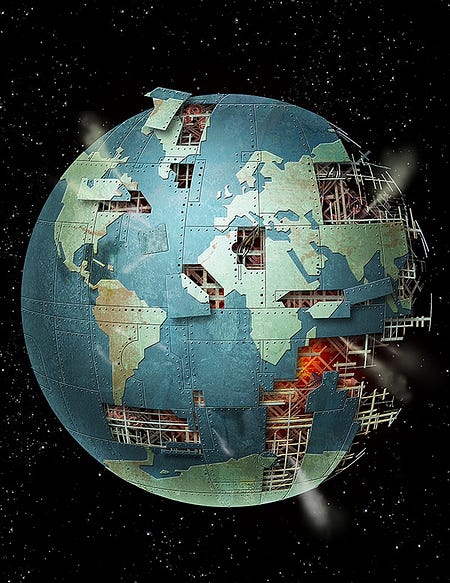
The Economist’s great issue: The Age of Man
Since we crawled up from the vast primordial ooze and evolved into Homo Sapiens, we’ve radically changed everything we’ve ever laid our hands on.
We dammed great rivers and harnessed their tremendous energy with turbines, while carelessly poisoning other rivers with heavy metals and trash. We cultivated a tiny group of plants that nurtured life and served us, while crushing biodiversity and setting off a chain reaction of devastating collapse in others. We domesticated a narrow range of animals we could lead to the slaughter or keep around us because they made us smile, while condemning others to extinction on an epic scale.
Now the long tendrils of our influence has spread to the stars.
And our influence moves faster than it ever has before.
Everything is accelerated. Culture. Economics. Technology development.
Evolution moves at stomach churning speed.
Entire boom-to-bust cycles happen in months instead of decades. Future shocks that would have Earth civilizations rioting in the streets if they happened once in a decade are now absorbed with ease. Economic crashes hit like mini-tsunamis and recoveries come just as quick.
A decentralized interplanetary Metaverse replaced the long dead Internet. The Metaverse is a living, breathing AR/VR tapestry that overlays the entire solsys with interactive avatars and objects and information, the info surging right into our contacts and augmented eyeballs.
Beyond the virtual and AR world the physical world has changed radically too.
Only about 1% o the population can drive anything at all, whether cars or ships, because everything from starships to ATVs drive themselves and self repair with redundant, hot swappable parts.
Driving is illegal, even in the far out frontiers of space at the edges of Neptune. Special permits for enthusiasts let crazy humans who think they can handle a sports car hurtling along at breathtaking speeds on the new Autobahns of the solar system take their lives into their own hands.
In politics and business, the vast AI backbones that power interplanetary business, governments and DAOs, spin the wheels of commerce with superhuman speed. The decision making of old world business and government happened in slow motion by comparison, as bitter old men horse-traded and argued and demonized their enemies and eventually got some broken law passed.
The political elite that once ruled over us has given way to direct democracy, powered by AIs that vote for us on 99% of issues because they already know what we’ll do. Just fill out a few quick questions and the system already knows what you think and it adapts as you change and express your views to it over time. We can always audit or change the vote for a short period after the vote, recorded to immutable quantum cryptographic chains with zero knowledge proofs, but it’s rare for anyone to do it.
And yet the elites are still there, as they always are, their influence more subtle, hidden in the background. They act as shadow cliques ruling with soft power instead of hard.
Politics is no longer nations against nations but planets against planets.
Three interplanetary wars have ripped the fragile commonwealth, the last of which destroyed the budding civilization of Mars, forcing a new generation to start again, after gene-hacked roaches chewed through the deadly radiation from planet busting Quark bombs.
And the people who control the new dynasties and city states make the old emperors and presidents of Earth, squabbling over tiny patches of dirt, look like the Neanderthals they always were, even if they didn’t know it.
More than anything, the people in control know they can’t run the economy alone. They let the machines do it because everything moves at a speed too fast for even augmented minds to handle.
The AIs simply adjust the dials of supply and demand in real time, ratcheting factory production up or down and triggering advertisement freezes to control consumer cravings that won’t get met for months. Then they fire those ads up again as goods come off the production line sizzling hot. The ads are micro-calibrated to every person, surging past their defense mechanisms like tailored drugs surging through the blood brain barrier. The machines know our wants and needs better than we do and give it to us before we even know we want it.
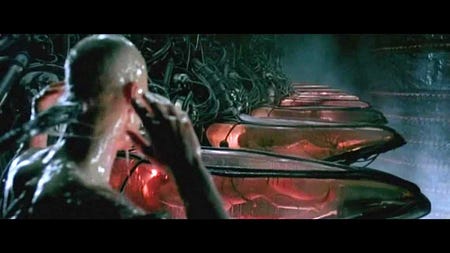
The rise of AI taught us that humans are nothing but another input and output. Words and emotions are the programming language and the machines can program us with ease.
But this is not the Matrix. We are not slaves.
We want them to program us.
We’ve never known more happiness or fulfillment in any other era. The primitive psychological drugs that we once took hundreds of years ago pale in comparison to regulated brain chemistries balanced by nano insects, programmed by minds vaster than our own to keep us happy and focused as an enlightened guru.
We once imagined we were the only masters of our destiny and the sole captain of our ships. Our minds were made up by our own free will.
But we know it’s not true now.
As we untangled the inner mysteries of our minds’ complex electrochemical field we realized we were just another kind of artificial intelligence, one evolved through the great genetic algorithms of the Earth’s biome.
And with that understanding, humanism, the belief that we were special creatures, touched by the hand of an invisible creator, different from the other animals, died a slow death.
The people alive now look back on us today and wonder how we ever imagined we could shape our own destiny and that we weren’t shaped by the subtle tides of our own invisible programming?

“More human than human. That’s our motto.” — Tyrell
But can these people even be called people?
No.
They’re not like us. They feel differently. Think differently. Look differently. They’re as different as we are to Cro-Magnon man.
They’re not human. They’re something more.
Posthuman.
The End of Man
The AI alarmists were right to fear that AI would bring about the end of humanity.
But they were wrong about how it happened.
It wasn’t a nightmare of Superintelligent machines. Those were nothing but the fevered dreams of a primitive people, Frankenstein for the social media age. It wasn’t sentient machines that suddenly gained awareness and decided to exterminate us like roaches.
Instead, AI moved inside of us.
Merged with us.
Transformed us.
Metamorphosis.
We embraced AI at deeper and deeper levels. It became more intimate than our all time best lover, whispering in our ears, knowing what we want before we want it.
It sprang out of our phones, glasses and smart clothes and into our heads, eyes, arms and legs. Like the long tendrils of rose roots it laced its way around the dendratic forest of our minds and enhanced them to incredible new levels.
We could run vSelves, entire virtual copies of our personalities in parallel, doing hundreds or thousands of tasks at once, making calls, running numbers, learning new skills, or solving crimes.
Or we could spawn another variation of ourselves just to have someone to talk to and keep us company when someone broke our heart.
And we could even spawn new iterations of our personality in a sandbox to see what kind of changes would make us better or more balanced or more ruthless, more cunning or more caring, or more decent or kind or tender or loving.
We became our own artificial evolution.
Posthuman people think nothing of upgrading themselves the way we used to flip out phones every few years.
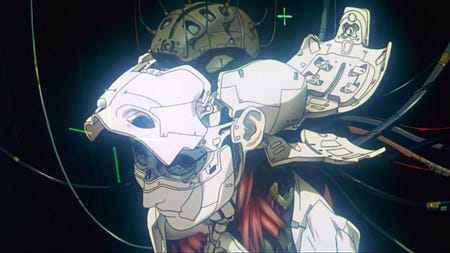
Ghost in the Shell.
Replacing your arm with a prosthetic that lasts five times as long as a natural one and doubles the tactile sensations is the same as buying a new dress or a pair of jeans.
Swapping out your eyes for ones that see better than 20/10, can see in the dark and show you a rich overlay of meta-information about the world makes perfect sense to someone with a mind upgraded at birth with post-CRISPR gene editing that’s 99.9999% accurate.
Mothers and fathers screen their children for diseases before they’re born and buy tweaks to intelligence and athletic ability and longevity. It’s common to have children born in exo-wombs so women don’t have to suffer the pain of childbirth. And children get better nutrients when they’re no longer beholden to the ice cream and pickle cravings of their mothers.
Kids are grown like hydroponic plants in the home.
And more and more technology moves deep inside of us, biomonitors that monitor cholesterol and stress, vast arrays attached to our spines that let us backup and snapshot our minds, and tiny swarms of nano machines that constantly clean our arteries and repair damage done by free radicals and hunt down cancer cells before they can spread their deadly genetic payload to other victim cells.
Tech lives inside us because it’s no longer made of poisonous rare Earth metals. It’s true “soft” ware.
We evolved to use the same basic building blocks as Mother Nature.
Carbon.
Our hardware become wetware. We became what we always were:

And it wasn’t just carbon that we could now control with ease. Our powers extended down so much further, to the atomic level.
3D printers evolved to molecular printers, which evolved to atomic printers.
Once we could create things atom by atom, the old scarcity economies of Earth no longer made any sense in the face of near limitless abundance. If you had the right printers and the right supply of the basic building blocks of matter you could print up any object from nothing.
Out of nothing. Into nothing.
Control at the atomic level changed the very idea of medicine. No longer did we interact with disease at the chemical level. We could just snapshot a person’s atomic fingerprint at a point in time and reset them to healthier state.
Cancer detected. Cells reset to pre-cancerous state.
We could roll back the sands of time on our cells.
That is, if you had the power and money to do it.
The One Becomes the Ten Thousand Things
More than anything the AIs moved us from the random evolution of Mother Nature to directed evolution.
We accelerated evolution like mad conductors in a great symphony.
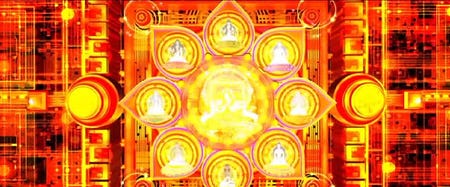
The AIs can sim through billions of years of evolution in days or months, depending on how many variables we let them process. Even the most powerful intelligent machines can’t process every variable in the known universe, but sometimes a reduced data set is enough.
Because of this hyper-accelerated evolution, posthumans are not a single species. We’re thousands of different species now. With aggressive gene editing and prosthetic and virtual versions of life we’ve shattered into a thousand daughter species.
Intensive new tribes exist. A single genetic tweak gives one group the power over others. Then their power fades as others adapt and counter their advances with new and better advances. Or that dominance fades, proving to be nothing but an experiment gone wrong.
Make people too smart and they easily drift into insanity and fugue states.
Make people better at spotting patterns and they spot them everywhere, even seeing them in splattered paint on the wall or in strange floor designs, giving meaning where there is none, making them fooled by randomness.
Yet it’s the most balanced posthumans who survive and thrive. They use cutting edge technology but take a conservative approach, not moving too quickly or too slowly.
They work with the AIs, in a co-creative process, true centaurs.
We dance with the AIs and they dance with us.
Creativity is no longer just a singular artist working away like a monk in a cave or a team of creative pros hammering it out on story boards. Scientists don’t experiment with tiny teams, using brute force to try idea after idea, they simulate thousands of years ahead for promising paths first. Toy designers creating the next toy that every kid craves don’t work alone in Geppetto’s workshop. Everything from fashion design to materials science changed as massively parallel genetic algorithms SIMed through millions and then billions of years of evolution to help us.
The AIs even designed better AIs, helping us build better versions of our own neural networks. We miniaturized the already small neuron, pushing it past the 1 to 4 micron scale and packing these artificial dendratic forests onto pebble sized arrays we injected into our bodies and minds.
And all of this accelerated evolution meant only one thing for the Sapiens who once ruled the small blue planet of Earth with ease.
Annihilation.
Waves Crashing on the Distant Shores of Time
Regular humans disappeared slowly and the quickly.
At first radical experimental humans, proto-posthumans who hacked their minds and bodies, were beaten back and killed off and jailed by their violent and ignorant Sapien predecessors. When people tweaked their bodies to add gills, or a third arm, they became easy targets of prejudice and police and genocide.
But over time, posthumans got smart.
They stopped making radical body changes that stood out and instead tweaked their minds and their bodies in secret, in areas that set themselves up as safe havens or future proof hideaways, the way Singapore set itself up as the ideal business environment or Zug, Switzerland set itself as the center of the crypto universe once upon a time long gone.
And soon those posthumans were rising to power all over the world. They were smarter, faster, better looking, more charming. They were hypnotic to regular Sapiens, who struggled to resist their allure.
Slowly the laws changed. Culture changed. What was acceptable changed.
More and more Sapiens altered little things about themselves too. Why let your child face a deadly disease?
If you could take a pill and double your metabolism so you could eat burgers every day and stay thin, why wouldn’t you?
It wasn’t a smooth transition. Evolution never is. It moves in fits and starts. There were backlashes, setback: economic shocks that saw the rise of authoritarians who used the radical changes as scapegoats that led to horrific genocides and brutality.
Early Patternists were death marched into oblivion.
The first attempts to build people that could live longer than everyone else were ironically singled out and slaughtered.
But like all violent movements, the raging storm eventually runs out of fury. And progress moves ahead once more, unfettered.
And eventually the Sapiens are nothing but a small tribe of people, clinging to a long forgotten past. They fight back, but like the Neanderthals before them, they face an enemy that can out think them, out perform them and out organize them.
To the posthumans Sapiens are no smarter than wild horses and just as easily slaughtered if they decide to go mad.
The last Sapiens imagined they could stop the future.
But just as the Japanese once tried to keep guns off the island to preserve the power of the sword, they learned that eventually gun beats sword.
And eventually posthuman beats human.
Nothing can hold back the tides of time.


